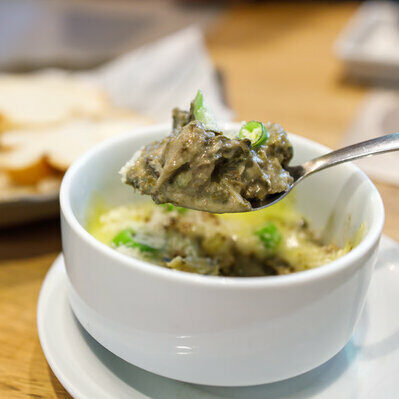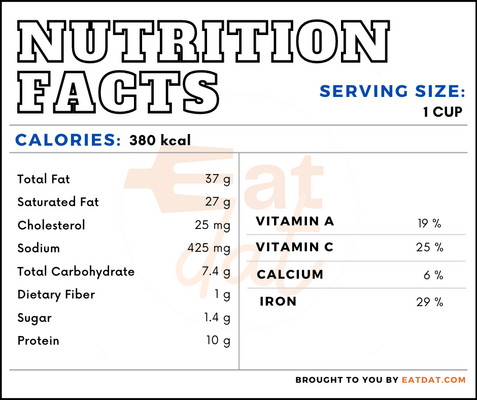
Laing
also known as Pinangat
What is Laing?
Laing is a Filipino dish made with pork, taro leaves, and coconut milk in the form of a stew. Seafood or other meats may be used instead of pork.
- Spices such as chilies, lemongrass, garlic, ginger, shallots, and shrimp paste may also be added.
- It is classified as a ginataan, the name for Filipino stews cooked in coconut milk.
In its native region of Bicol, this dish is known as pinangat. Laing is spicy and creamy and may be served with rice, fish, meat, or bread.
The top 10 most popular Filipino dishes are:
- Adobo
- Sinigang
- Lechon
- Kaldereta
- Kare – Kare
- Sisig
- Bulalo
- Laing
- Bicol Express
- Tinolang Manok
Origin of laing
This dish was invented in the Bicol region of the Philippines. It is an indigenous dish that has been prepared for a long time without outside intervention or influence. Coconut, which is one of the main crops in this region, facilitated coconut and coconut milk based dishes, including laing or pinangat. Also, the region has an abundance of taro. The dish is known as pinangat in the Bicol region, but is known as laing elsewhere in the Philippines and abroad.
Nutrition
Nutritional profile for laing (1 cup):

Red meat is rich in sodium, calcium, iron, fatty acids, and amino acids. It is a good source of high biological value protein and essential nutrients that are more bioavailable than in other food sources. In addition, it is a good option for increasing satiety and limiting obesity. However, regular consumption of red meat may lead to cardiovascular diseases, some types of cancers, and obesity.
Coconut milk is rich in phenolic compounds that provide protection against oxidative stress. Regular consumption of this drink can help in decreasing LDL and increasing good cholesterol. Additionally, the lauric acid in the milk promotes brain development, boosts the immune system, and maintains the blood vessels. Furthermore, it aids in preventing aging, cooling, digestion, and providing nourishment to the skin.
Taro leaves are rich in taro lectin or tarin, bioactive-complex carbohydrates, and natural polyphenols and other antioxidants. Regular consumption may help in limiting the invasion of cancer cells. Also, it has antidiabetic, antihypertensive, immunoprotective, and neuroprotective properties.
Commercial production
To prepare laing, the ingredients required are taro leaves, coconut milk, meat/seafood, chilies, and aromatics such as shallots, ginger, garlic, lemongrass, and shrimp paste, according to preference. First, the dried taro leaves are dried and shredded. Then, the aromatics are heated in some oil until they soften and then the meat is added. The shrimp paste, if used, may be added at this point and the coconut milk is poured in and the dish is simmered. While it is cooking, the chilies and the lemongrass, and any remaining aromatics are added in along with the taro leaves. At this stage, the dish is just allowed to simmer and is never stirred until it is done cooking. Finally, cream or coconut cream and salt are added.
Pork must be kept in the freezer to maintain its freshness, and used within 5 days. Cooked pork dishes must be consumed within two hours or refrigerated right away. The meat may be thawed in cold water, in the microwave, or in the refrigerator. Leaving it to thaw at room temperature must be avoided to prevent harmful bacterial growth and food borne illnesses.
Laing recipes
This is a beloved Filipino dish that goes well with rice, bread, and meat dishes. It may be adjusted to suit specific tastes. Here are a few recipes to try:
FDA regulations
The USDA classifies pork as livestock and red meat. It is defined as meat from hogs or domestic swine. The FDA considers coconut as a fruit, and any liquid derived from it as a juice. Hence, coconut milk is classified as a fruit juice in the US. Taro and taro leaves are classified under raw agricultural commodities.
References
Karunasiri, Asiri N et al. “Antioxidant and Nutritional Properties of Domestic and Commercial Coconut Milk Preparations.” International journal of food science vol. 2020 3489605. 1 Aug. 2020, doi:10.1155/2020/3489605, https://www.ncbi.nlm.nih.gov/pmc/articles/PMC7422486/
Gupta, Kritika et al. “Potential of Colocasia leaves in human nutrition: Review on nutritional and phytochemical properties.” Journal of food biochemistry vol. 43,7 (2019): e12878. doi:10.1111/jfbc.12878, https://pubmed.ncbi.nlm.nih.gov/31353694/
Ayesha Fontilla, 15 Most Popular Filipino Dishes, Chef’s Pencil, https://www.chefspencil.com/15-most-popular-filipino-dishes/
